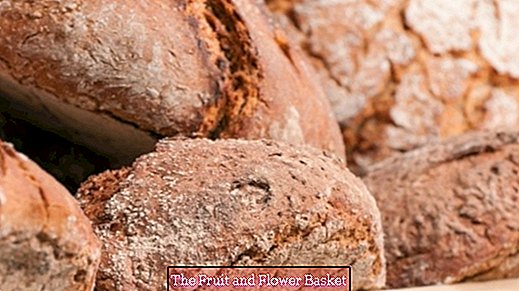Bake wheat mixed bread yourself
equipment:
- Large mixing bowl, medium flat bowl, small bowl
- Bowl for water
- whisk
- Rubber scourer
- flour sifter
- brush
- Food processor with dough hook
- baking sheet
- teaspoon
- kitchen scale
- Sharp knife (without saw)
- kitchen towel
ingredients
The ingredients correspond to about one kilogram of bread
- 470 grams of wheat flour
- in addition a little flour for all sorts of things
- 230 grams of rye flour
- two teaspoons of dry yeast
- a teaspoon of baking soda
- two teaspoons of salt
- a teaspoon of sugar
- about a teaspoon of margarine / butter
- about ½ liter of water
preparation
Time required: approx. 3 1/2 hours with long breaks
00:00
Preheat the stove to 40 degrees and insert the grate on one of the lower rails.
Since I keep the flour in the fridge or in the freezer, I weigh 470 g of wheat and 230 g of rye flour, and mix this in the large bowl. Then I put them in the stove for preheating. Stir gently in between times with the whisk, as the flour warms up slowly at this temperature.
Bring warm (about 35 - 40 degrees) water (about 200 ml / cup), a heaped teaspoon of sugar and two heaped teaspoons of dry yeast in the middle bowl together with the whisk.
00:30
Put the bowl with the yeast into the oven for 30 or more minutes.
01:05
Shortly before the yeast is taken out of the oven, remove the flour from the heat and mix two heaped teaspoons of salt and a slightly heaped teaspoon of baking powder with the whisk and form a chill in the middle.
Then pour the yeast / water mixture into the Kuhle and stir in with the dough hook. Gradually add about 200-220 ml of warm water. Kneading time: not less than 5 minutes! Knead the dough until it pulls around the dough hooks.
01:15
Cover with a damp kitchen towel and put in the preheated tube for at least 30 minutes.
In the meantime grease the baking tray with the butter / margarine and sprinkle with the flour sieve thinly with flour.
On the kitchen table with the flour sieve, sieve a surface of 50 x 30 cm thinly.
01:50
Take the large bowl with the dough out of the cooker, and with the rubber pot scraper on the side of the pot, separate it from the edge. Drop the dough dumpling into the flour. Grease your hands a little bit.
Knead the dough in the flour well by hand. Kneading time: not less than 5 minutes! This is very important! Take care that the dough does not get too much flour, otherwise it will be too dry!
Now the dough comes on the baking sheet and we cut with a sharp knife across about one centimeter deep in two centimeters intervals.
02:00
Put a little flour on top, then cover with damp kitchen towel and let it rest in the tube for 30 minutes or more.
Provide the small bowl with water and brush as well as the shallow dish with warm water as possible.
02:30
Remove the baking tray from the tube and preheat the oven to 230 degrees. Put the bowl in the oven. The bigger the shell, the better it is. Important: Do not place the bowl under the baking sheet, otherwise the bowl will take the bottom heat from the bread.
Brush / brush the bread with water at least four times. Only then does the bread get a nice, dark crust. Slowly stroke and make breaks in between. The stove needs its time to preheat anyway.
02:50
When the stove has reached its temperature, place the baking tray in the tube next to the hopefully boiling water in the bowl and bake at 230 degrees or more. The baking time is between 30 and 45 minutes. The bread should be dark, but not black. Especially the cut edges on the crust are fast black. The more water evaporates in the tube, the crisper the crust becomes. Approximately 5 minutes before the bread is ready, open the flap. As a result, the steam disappears and the crust is nicely crisp.
03:25
When the bread is ready, turn off the stove, remove it from the heat and let it cool on a small grid or an air-permeable coaster. To develop the right bread taste, the bread must cool before it is cut. Why? The bread shrinks because the air inside cools and creates a negative pressure inside. As a result, flavorings from the crust in the bread pure.
An even more detailed guide is available as pdf under my e-mail address.





